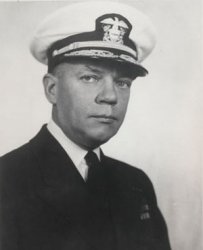
 |
|
|
||
|
Francis Stuart Low 'Frog' |
||||
|
Graduate, U.S. Naval Academy, Class of 1915 Engagements: • World War I (1914 - 1918)• World War II (1941 - 1945) |
||||
| Biography: | ||||
|
Francis Stuart "Frog" Low Francis Stuart Low was born in Albany, NY, in 1894. He was a graduate of the U.S. Naval Academy in 1915. During WWI he served in submarines and later worked on submarine and torpedo research. In 1923 he served on the staff of Rear Admiral M.M. Murray, Commander Control Force and Submarine Division 13. In 1926 he attended the Naval War College. From 1932 to 1935 he served on the staff of Submarine Squadron 5 and later assumed command of USS Paul Jones. Following he became Commander Submarine Division 13 in 1937. From December 1940 to August 1942, Low was the Anti-Submarine Warfare Officer on the staff of Chief of Naval Operations Admiral Ernest King. In this capacity, he flew to Norfolk, VA on 10 January 1942 to review the status of the Navy's newest carrier, USS Hornet (CV-8). Birth of the Doolittle Raid The Navy airfield at Norfolk had the outline of an aircraft carrier painted on it to help naval aviators remain proficient in their launch techniques. During this trip, he observed some B-25s making passes at that outline in a mock attack and realized that twin-engine aircraft would fit on the deck of a carrier. He wondered if the B-25s would be able to take off of a carrier. Upon his return to Washington, he went aboard Admiral King's headquarters, the USS Dauntless, and mentioned his idea to the Admiral who thought it had merit. King asked Low to bring it to the attention of his Air Operations Officer, Captain Donald Duncan to review. It was because of Low's observation that the Doolittle Raid came about. In September of 1942, he assumed command of the heavy cruiser USS Wichita (CA-45) and participated in Operation Torch, the Allied invasion of North Africa. After transiting to the Pacific Ocean in early 1943, Wichita was involved in the battle of Rennell Island in the Solomon Islands. In March 1943, he was recalled to Admiral King's staff and became the key architect and organizer of the new Tenth Fleet. While Admiral King was the nominal commander of this fleet, Rear Admiral Low ran the daily anti-submarine operations during the ongoing struggle/battle with German U-boats. A gifted leader, he coordinated the multi-service activities in this massive effort to defeat the U-boat fleet during WWII. He encouraged extensive research and development cooperation within both the military and scientific communities. With the enemy submarine threat in the Atlantic having been eliminated by 1945, Low returned to the Pacific theater, Commanding Cruiser Division 16 during the invasions of Iwo Jima and Okinawa. Later that year, he became Commander of Destroyers for the Pacific Fleet. In 1947, he was Commander of Services for the Pacific and became the Deputy Chief of Naval Operations for Logistics in 1950. Later, he was designated the Commander of the Western Sea frontier in 1953 and remained in that command until his 1956 retirement. Upon his retirement in July 1956, he was advanced in rank to four-star Admiral. * * The Act of Congress of 4 March 1925, allowed Navy officers to be promoted one grade upon retirement if they had been specially commended for performance of duty in actual combat. These promotions were colloquially known as "tombstone promotions" because they conferred the prestige of the higher rank but not the additional retirement pay, so their only practical benefit was to allow recipients to engrave a loftier title on their business cards and tombstones. An Act of Congress on 23 February 1942, enabled tombstone promotions to three- and four-star grades. Medals and Awards As Rear Admiral, he was awarded the Navy Distinguished Service Medal for managing the aggressive campaign against enemy submarines in the Atlantic Ocean during the period of March 1943 thru January 1945. As Vice Admiral, he was awarded the Legion of Merit with Combat "Valor" Device for Commanding the Cruiser Support Unit operating with a fast carrier task force during the invasions of Iwo Jima and Okinawa from March thru June of 1945. Death and Burial Admiral Francis Stuart Low died in 1964. He is buried at Mountain View Cemetery in Oakland, CA, in Section 9. |
||||
| Honoree ID: 588 | Created by: MHOH | |||
Ribbons
Medals
Badges
Honoree Photos
 |  |  |
 |  |
 |


